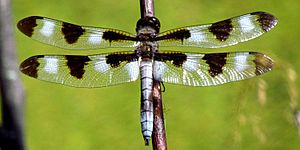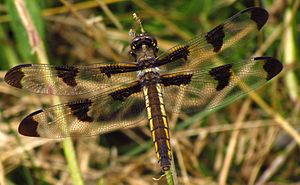Twelve-spotted skimmer facts for kids
Quick facts for kids Twelve-spotted Skimmer |
|
|---|---|
 |
|
| male | |
 |
|
| female | |
| Scientific classification | |
| Kingdom: | |
| Phylum: | |
| Subphylum: | |
| Class: | |
| Order: | |
| Suborder: | |
| Family: |
Libellulidae
|
| Genus: |
Libellula
|
| Species: |
L. pulchella
|
| Binomial name | |
| Libellula pulchella (Drury, 1770)
|
|
The Twelve-spotted Skimmer (Libellula pulchella) is a common and beautiful type of dragonfly found across North America. You can spot these amazing insects in southern Canada and almost all parts of the United States. They are known for their unique wing patterns, which make them easy to recognize!
Meet the Twelve-spotted Skimmer
The Twelve-spotted Skimmer is a type of skimmer dragonfly. It's a very common sight near ponds, lakes, and slow-moving rivers. These dragonflies are important parts of their ecosystems. They help control insect populations and are also food for other animals.
What Does it Look Like?
The Twelve-spotted Skimmer is a fairly large dragonfly. It can grow to about 50 mm (2.0 in) long. That's about the length of your thumb! Each of its four wings has three dark brown spots. This gives it a total of twelve spots, which is how it got its name.
Adult male skimmers have even more interesting patterns. They develop extra white spots between the brown ones. They also have white spots at the base of their hindwings. Because of these white spots, males are sometimes called the Ten-spot Skimmer. This name comes from the ten white spots you can see on their wings. Female skimmers and younger males do not have these white spots.
Where Do They Live?
You can find the Twelve-spotted Skimmer all over North America. They live in southern Canada and in all 48 of the contiguous U.S. states. They prefer to live near water, like ponds, marshes, and slow streams. These watery places are where they lay their eggs and where their young grow up.
Like all dragonflies, the Twelve-spotted Skimmer is a skilled flyer. They can hover in the air and dart quickly to catch insects. They are often seen flying over open water or resting on plants near the water's edge.

